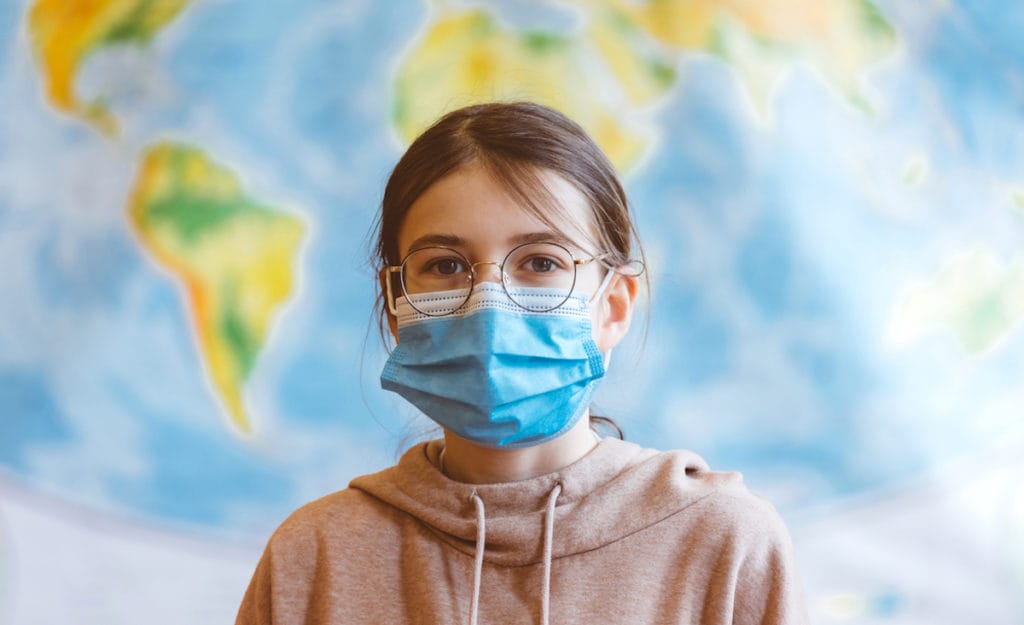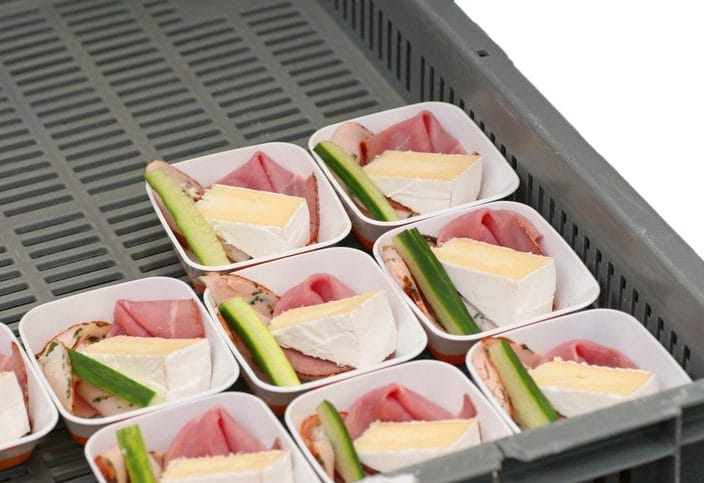
As families emerge from the COVID-19 lockdown, masks at the ready, many are thinking ahead to autumn – and the return of school.
For most parents, the top-of-mind issue is keeping their kids safe from coronavirus exposure. Challenging school situations will include how to keep a room of 6- or 7-year-olds “physically distanced.” But food allergy families have an additional layer of concern. They simultaneously need to know what happens to their students’ food allergy accommodations. As schools enter a new world of pandemic protocols, potential conflicts are arising.
The Centers for Disease Control and Prevention has released some pandemic planning guidance for school administrators. In these documents, a familiar hot button for food allergy families emerges: Food in the classroom.
In early May, the CDC first posted interim guidance for K-12 school administrators. The federal health agency suggests that schools avoid having students “mixing in common areas.” To help prevent that, the CDC recommends that schools in most cases: “allow students to eat lunch and breakfast in their classrooms rather than mixing in the cafeteria.”
Ohio physician Amanda Holbrook’s 11-year-old is severely allergic to eggs, peanuts and tree nuts, and has severe asthma. Her daughter is one of many kids with food allergies who has a 504 disability plan. Hers specifies that food won’t be eaten in the classroom, to reduce the risk of a dangerous reaction. When it comes to eating food in class, says Holbrook, “that’s a hard stop for me.”
She’s far from the only parent who feels that way. After the CDC’s interim guidance was posted, food allergy families began telling Allergic Living that the pandemic measures were at odds with students’ accommodations plans.
Nonprofits Raise Concerns
The nonprofit groups saw this, too. On May 6, FAACT (Food Allergy & Anaphylaxis Connection Team) wrote to CDC director Dr. Robert Redfield, requesting an exception in the guidelines. FAACT asks that classrooms which include children with severe food allergies be listed as “a specific incidence where it is not possible to suspend use of common areas.”
That same day, FARE (Food Allergy Research & Education) and a group of eight other allergy and health nonprofits* sent their own letter to Redfield. That group recommends a food allergy strategy for schools of: strict handwashing after food contact, disinfecting surfaces after eating, and a blanket “do not share food policy.”
FARE is also raising the food allergy concerns by sending letters to public health officials and school superintendents across the U.S., and is doing the same with state governors. FAACT, meantime, has informed school administrators, school nurses and pediatricians.
The CDC has clearly taken notice of the nonprofits’ concerns. On May 17, the CDC posted a 60-page document of recommended initiatives to support the COVID-19 response and the federal government’s plan for reopening America. Sections on opening schools still recommend having meals in classrooms to reduce coronavirus transmission risks. But now there’s phrasing about ensuring “the safety of children with food allergies,” and an accompanying “Considerations for Schools” document. It recommends:
“Have children bring their own meals as feasible, or serve individually plated meals in classrooms instead of in a communal dining hall or cafeteria, while ensuring the safety of children with food allergies.” This statement links to the allergy community’s go-to school resource: the CDC’s Voluntary Guidelines for Managing Food Allergies in Schools and Early Care Programs, first published in 2013.
The agency’s new pandemic documents cover a lot of ground, and the food allergy mentions are brief. To communicate the importance of food allergy risks to school administrators, the question is: Are these sufficient? Let’s explore with some leading voices in the area of schools and food allergy rights, and also consider the rights of students who already have accommodation plans.
The CDC’s Words Matter
Amelia Smith, an attorney and FAACT’s vice president of civil rights advocacy, argues the CDC guidance needs to be more explicit. She understands the daunting communications task the CDC faces with the pandemic. But she also knows the food allergy risks in schools. Plus, she has seen the problems when highly allergic kids and allergens mix in class.
“We have seen it happen time and again where students themselves are given the responsibility of cleaning up a milk spill. Six-year-olds don’t do it well. Even teenagers often don’t do it well,” she says. And when there are spills or smears, that often leads to heightened anxiety for allergic kids, and impedes their ability to focus on schoolwork.
In a follow-up letter to the CDC, FAACT asks for a specific caveat that would allow a student with food allergies to eat outside of the classroom – “if doing so poses a safety or health risk to students with food allergies or violates federal disability laws.”
Retired civil rights consultant Jim Long also favors more direct food allergy reference to guide school administrators. “It would be really helpful if the CDC would amend the new guidelines to acknowledge they may have very obvious implications for students with severe allergies or disabilities. And to say that account will have to be taken of those disabilities in designing how those classrooms are going to function,” says Long, who is a former senior attorney with the Department of Education’s Office for Civil Rights (OCR).
What the CDC recommends matters. “Although the guidelines the CDC put forward are technically voluntary, they carry an incredible amount of weight because they come from the CDC and the governors are listening to the CDC,” notes Lisa Gable, FARE’s CEO.
In the group letter led by FARE, those nine nonprofits also seek wording revisions to the new guidance. But they take the approach that the CDC’s recommendation to eat in the class “may be unavoidable” during the pandemic. The language these groups seek would reinforce their three points of: handwashing, disinfecting and no food sharing. As well, Gable says, “we’ve asked the CDC to include a sentence that prior to teachers and school leaders returning, they need to refresh their understanding of food allergies, symptoms and the response to food-allergic reactions.”
Class vs. Cafeteria or Other

Gina Clowes, FARE’s former national director of training, worked for three years as the program director for the CDC’s voluntary food allergy guidelines. She is steeped in the nuances of school situations and, with food allergies, usually strongly favors food being eaten in the cafeteria rather than the classroom.
But Clowes notes that managing the pandemic, especially in harder-hit areas, is an unprecedented situation. There is potential for students to get exposed to the coronavirus and bring it home to a vulnerable relative. So she recommends food allergy families keep an open mind and weigh the range of possible solutions with their school. “There may be numerous options, and we may actually choose ‘food in the class’ in certain cases. We have to look at both of these serious health situations.”
Physician-mom Holbrook would debate the CDC’s idea that it’s medically preferable to keep kids eating in class during the pandemic rather than in the cafeteria. “In a class, you’ve got kids on top of each other, and class spaces are harder to clean. They’ve often got carpet, they’ve got pencils, notebooks and backpacks and all kinds of things you can’t appropriately disinfect.” She notes that cafterias are designed for infection control and have easy-to-clean surfaces.
Holbrook works for healthcare navigation company, and is handling frequent telemedicine calls related to COVID. For the return of school, “I’m worried we’re saying that COVID-19 is more important, and that children’s other medical conditions are second. That cannot happen; these children still need their medical needs met.” Holbrook is also concerned about the use of strong disinfectants in the class, an asthma trigger for children like her daughter.
The physical environments of schools and the number of kids enrolled with food allergies can vary markedly. That’s why FARE’s Gable calls it “imperative that parents and food allergy advocates lend their voices and work directly with their schools to see to it that the safeguards for food-allergic children are pulled through to the end.”
Smith of FAACT notes that accommodations plans themselves are individualized – based on the specific needs of a student. While her organization wants the CDC to recommend a caveat on classroom eating, Smith says workarounds can then be tailored to individual situations. One example she offers is that just classes including kids with food allergies could eat in the cafeteria (or other common area). A smaller number of students would make it easier to employ physical distancing within the cafeteria.
Individual Rights Are Intact
Clearly the school situation this fall will be challenging. But Long makes an encouraging point. If your student’s food allergy has qualified as a disability and the child has a 504 plan (or IEP or other accommodation plan), it still applies.
With the disability confirmed, “the school has to provide a ‘Free and Appropriate Public Education,'” (known as FAPE). “The student has to be given all the special education services that are necessary to provide an equal opportunity to enjoy the benefits of the school’s educational program,” he says.
“This is going to be challenging, but the fact that it is challenging doesn’t diminish the requirements of Section 504,” says Long.
The attorney recommends families review their student’s plan with the 504 team in light of any pandemic plans the school will institute. Smith agrees and her advice is that if you don’t yet have a 504 plan for your child with severe allergies, “start working to get one.”
Smith and Clowes each recommended sitting down and drafting out your student’s specific needs in relation to the school’s environment. It may not be possible yet to get a meeting with the 504 coordinator, but you can get your own thoughts organized.
Meantime, the nonprofits will keep pressing the CDC to address food allergy concerns more specifically. Without such language, Smith says her group fears “that a lot of school districts are going to hang their hat on the CDC guidance documents, and use that as a reason to modify 504 and other accommodations plans. There are workarounds, this does not have to become an adversarial situation with schools. But we need the CDC’s help to ensure school administrators understand.”
Do you have concerns about ongoing food allergy accommodations discussions with your school in light of the pandemic? FAACT’s Amelia Smith is tracking issues. Write to: [email protected].
*The 9 nonprofits involved in the group letter to the CDC are: FARE, Asthma and Allergy Foundation of America, End Allergies Together, Allergy & Asthma Network, Elijah-Alavi Foundation, AllergyStrong, Food Equality Initiative, National Association of Nurses and School-Based Health Alliance.
What a 504 Plan Does
In the United States, children with food allergies often qualify for a federal 504 plan, which provides equal access to services and activities provided to eligible students by any school that receives federal assistance.
The plan draws its name from Section 504 of the Rehabilitation Act of 1973. Food allergies may be considered a disability under the Rehabilitation Act, since they can impair “major life activities” (e.g. eating and breathing).
To be protected under Section 504 regulations, a student must be found eligible as “disabled” under the Americans with Disabilities Act. If there are additional disabilities, students may also require an Individualized Education Program (IEP).
Related Reading
CDC activities and initiatives supporting the President’s plan for opening America
CDC’s “Considerations for Schools” document
Voluntary Guidelines for Managing Food Allergies in Schools and Early Care
Letters from FAACT to CDC
Letter from FARE and other 8 nonprofits to CDC
Allergic Living Resources
Food Allergies at School: Steps to Keep Your Child Included
7 Mistakes to Avoid at a 504 Meeting





